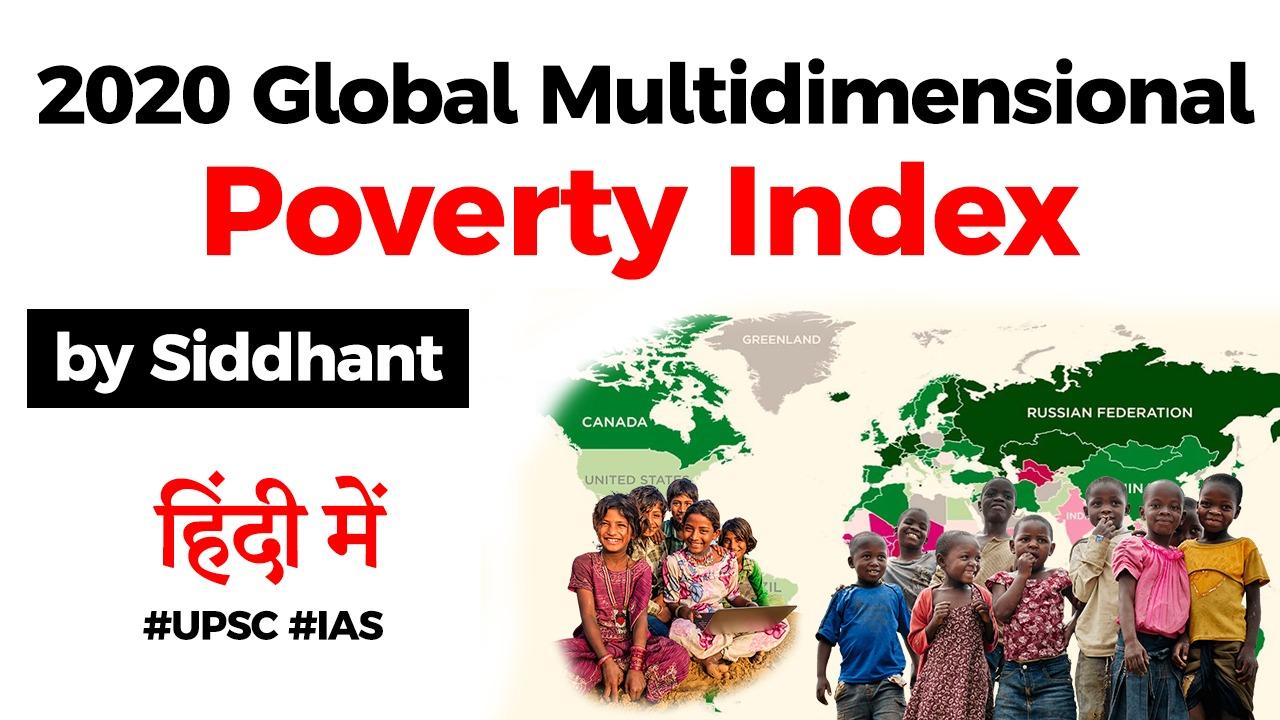Table of Contents
MPI
- Multidimensional Poverty Indices use a range of indicators to calculate a summary poverty figure for a given population, in which a larger figure indicates a higher level of poverty.
- The Global Multidimensional Poverty Index (MPI) was developed in 2010 by the Oxford Poverty & Human Development Initiative (OPHI) and the United Nations Development Programme and uses health, education and standard of living indicators to determine the incidence and intensity of poverty experienced by a population.
- It has since been used to measure acute poverty across over 100 developing countries. The Global MPI is released annually by UNDP and OPHI and the results published in their websites
STUDY
- Recently, Global Multidimensional Poverty Index 2020 was released by the United Nations Development Programme (UNDP) and the Oxford Poverty & Human Development Initiative (OPHI).
- The data of the index is based on the study of poverty trends in 75 countries.
INDICATORS
- It considers estimates progress under 10 indicators, according to the NITI Aayog report:
- Nutrition
- Child mortality
- Years of schooling
- School attendance
- Cooking fuel
- Sanitation
- Drinking water
- Electricity
- Housing
- Assets
GLOBALLY
- The MPI was observed in 75 countries from the East, Central and South Asia, Europe, Latin America and the Caribbean, Sub-Saharan Africa as well as the Pacific. The report was meant to provide a comprehensive picture of global trends in multidimensional poverty covering five billion people.
- The study has found that four countries — India Armenia, Nicaragua and North Macedonia — have reduced their MPI by half or more in 5.5 to 10.5 years.
POVERTY
- According to the study, 65 out of the 75 countries that were studied have lowered their MPI value and 50 nations have even reduced the number of people living in poverty.
- Approximately 273 million people moved out of multidimensional poverty in India, the study noted. It also states that three South Asian nations — India, Bangladesh and Nepal — were among the 16 fastest countries to reduce their MPI value.
POVERTY IN INDIA
- At least 271 million people were lifted out of multi-dimensional poverty between 2005-06 and 2016-17, claimed India’s Voluntary National Review (VNR) of Sustainable Development Goals (SDG).
- The estimates presented were drawn from the 2019 global Multidimensional Poverty Index (MPI) released in July 2019.
- According to the global MPI, over 640 million people across India were in multidimensional poverty in 2005-2006. The number people living under poverty decreased to around 369.55 million by 2016-2017.
POVERTY IN INDIA
- According to the study, 55.1 per cent of the population in India lived under multidimensional poverty in 2005-06. In 2015-16, it came down to 27.9 per cent.
- As of 2015-16, the intensity of deprivation was 43.9 per cent, while the population under severe multidimensional poverty was 8.8 per cent.
- According to the study, 37.7 crore people in India lived under multidimensional poverty as of 2018.
- As of 2016, the percentage of people in India who were deprived of nutrition was 21.2 per cent. People who were deprived of cooking fuel was 26.2 per cent. Those deprived of sanitation and drinking water were 24.6 per cent and 6.2 per cent respectively. Deprivation of electricity and housing figures stood at 8.6 per cent and 23.6 per cent for the year.
POVERTY IN INDIA
- The study also highlights the correlation between multidimensional poverty and immunisation. The percentage of children receiving three doses of diphtheria, tetanus and pertussis (DTP3) vaccines had been used as an indicator of how well countries were providing routine immunisation.
- According to the study, 10 countries accounted for 60 per cent unvaccinated children. Around 40 per cent of the children who were not vaccinated for DTP3 lived in four countries — India, Nigeria, Pakistan and Indonesia.
- The report also stated that populated developing countries could contribute considerably to a large number of unvaccinated children despite achieving high immunisation coverage. The study cited India as an example where 2.6 million children were “undervaccinated”.
Latest Burning Issues | Free PDF






















 WhatsApp
WhatsApp